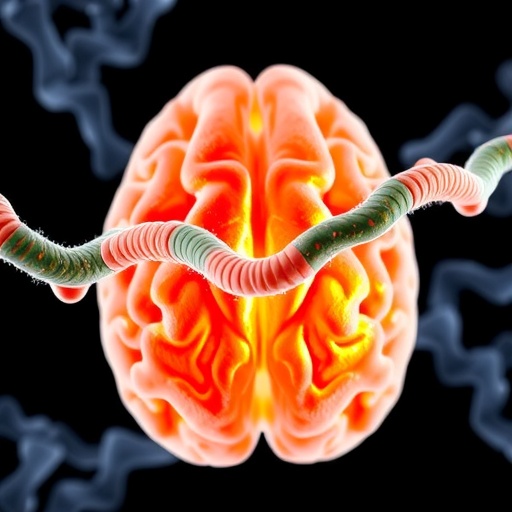In the ever-evolving landscape of biomedical engineering, the quest for smarter, more intuitive monitoring systems has taken a remarkable leap forward with the advent of soft bioelectronic devices integrated with DNA circuits. A groundbreaking study led by Zhao, Huang, Zhang, and their colleagues unveils an innovative approach that marries the softness and flexibility of bioelectronics with the precision of DNA-based molecular computing to revolutionize chronic wound monitoring. This pioneering research, recently published in Nature Communications, epitomizes the fusion of molecular biology and flexible electronics, promising unprecedented fidelity in real-time diagnostic applications.
Soft bioelectronics, heralded for their mechanical compatibility with living tissues, have increasingly become pivotal in medical diagnostics and therapeutics. However, their potential has often been limited by the lack of intrinsic intelligence to process biochemical signals directly at the site of interest. The integration of a self-confined tetrahedral DNA circuit into these devices marks a significant breakthrough. This DNA circuit, designed through the principles of structural DNA nanotechnology, forms a stable and programmable scaffold capable of executing logic operations and signal amplification in situ. Such a mechanistic design not only enhances the signal-to-noise ratio but also confers specificity to the bioelectronic interface, enabling chronic wounds to be monitored with an unprecedented degree of accuracy.
Chronic wounds, characterized by their persistent and often elusive healing trajectories, present a formidable challenge in clinical care. The complex biochemical milieu of these wounds, often involving fluctuating levels of enzymes, inflammatory markers, and pH changes, demands a sophisticated sensing system capable of dynamic adaptation and high-resolution detection. Conventional wound monitoring techniques typically fall short, offering limited temporal resolution and often necessitating invasive sampling. The DNA circuit-embedded soft bioelectronic devices circumvent these constraints by providing real-time, continuous monitoring directly at the wound site. Their molecularly programmable nature allows the sensors to discriminate specific biomarkers within a complex biological environment, greatly improving diagnostic precision.
Central to the functionality of this system is the tetrahedral DNA framework, a nanostructure with remarkable spatial configuration and chemical stability. Its rigid yet flexible geometry serves as a scaffold that can confine functional DNA probes in close proximity, facilitating efficient cascade reactions that amplify target signals. By self-assembling into a defined three-dimensional architecture, the DNA tetrahedron ensures uniformity and reproducibility essential for clinical applications. This architecture also affords protection to the DNA probes against enzymatic degradation in the wound’s harsh microenvironment, thus enhancing the device’s chronic operational viability.
The operational principle of the integrated DNA circuit revolves around a cascade of strand displacement reactions triggered by specific wound-related biomarkers. This bioorthogonal mechanism ensures that the system remains inert until encountering its target, thereby minimizing false positives. Upon detection, the DNA circuit undergoes conformational changes that generate an amplified electronic signal transduced by the soft electronic substrate. This integration of molecular recognition and electronic transduction within a single, flexible device is a testament to the researchers’ ingenuity in bridging biochemistry and materials science.
Moreover, the deployment of these devices in vivo highlights their remarkable adaptability and biocompatibility. The soft bioelectronic platform, fabricated from elastomeric and conductive materials, conforms intimately to the wound surface, maintaining intimate contact for continuous monitoring without inducing irritation or discomfort. The self-confined DNA circuitry embedded within is stable over extended durations, a critical attribute for chronic wound care which often spans weeks or months. The researchers demonstrated successful implantation on animal models with chronic wounds, observing sustained and reliable signal outputs that correlated precisely with wound status and healing progression.
Another cornerstone of this innovation is the system’s ability to not only detect but also distinguish multiple biochemical cues simultaneously, thanks to the DNA circuit’s programmable multiplexing capability. Chronic wounds exhibit a heterogenous biochemical landscape, and the capacity to monitor multiple biomarkers in concert enables a holistic assessment of the wound microenvironment. This multiplexed sensing approach opens new vistas in personalized medicine by facilitating tailored therapeutic interventions based on continuous, high-fidelity feedback.
The implications of this technology extend beyond chronic wound management. The modularity of the tetrahedral DNA circuit allows for customization to detect a broad spectrum of biomarkers relevant to various pathologies, including inflammatory diseases and cancer. By integrating diverse DNA probes within the same tetrahedral scaffold, the bioelectronic device’s sensing repertoire can be swiftly expanded, heralding a new era of adaptive, DNA-based diagnostic platforms.
From a materials science perspective, the integration of delicate DNA nanostructures into flexible electronics presented formidable challenges. The researchers overcame these by employing innovative immobilization techniques that preserve the DNA circuit’s structural integrity while ensuring robust electrical interfacing. The soft substrate’s conductivity was optimized to balance mechanical compliance and signal transduction efficiency, resulting in a device that seamlessly bridges molecular and electronic domains.
The study also contributes to the emerging field of biohybrid systems, where biological molecules confer molecular recognition and adaptability to synthetic platforms. The use of self-confined DNA circuits exemplifies how programmability and hierarchical assembly can be harnessed to imbue soft electronics with computational capabilities, transforming passive sensors into active signal processors capable of complex decision-making. This paradigm shift may inspire future bioelectronic devices capable of autonomous therapeutic interventions, including drug release triggered by precise biochemical cues.
Critically, the integration strategy ensures that the DNA circuits remain localized without undesirable diffusion or detachment, a common problem in molecular sensor designs. This self-confinement mechanism not only stabilizes the circuit but also confines the biochemical reactions spatially, enhancing the device’s sensitivity and specificity. The ability to retain functional DNA circuitry over prolonged periods within the biological milieu marks a significant technological advancement that can impact the longevity and reliability of bioelectronic devices.
Looking forward, this innovation paves the way for next-generation medical devices that are not only soft and conformable but also inherently intelligent. The coupling of DNA nanotechnology with flexible electronics holds vast potential for ultrasensitive diagnostics, real-time monitoring, and even closed-loop therapeutic systems. As chronic wounds and other complex wounds continue to impose significant healthcare burdens, technologies like this promise to transform patient care paradigms by enabling precise, data-driven management strategies.
Furthermore, this work underscores the importance of interdisciplinary approaches that merge the precision of molecular biology with the versatility of materials engineering and electrical design. Moving beyond traditional boundaries, such integration fosters the development of hybrid systems capable of meeting the multifaceted challenges posed by living tissues. This study is emblematic of how cross-disciplinary innovation can manifest as practical solutions with profound clinical impact.
In conclusion, Zhao and colleagues have demonstrated a compelling advance in the field of bioelectronics by embedding self-confined tetrahedral DNA circuits within soft diagnostic devices for chronic wound monitoring. This approach not only enhances the fidelity and specificity of biomarker detection but also introduces novel paradigms for integrating molecular computation with flexible electronics. The implications for patient care, personalized medicine, and bioengineering are profound, heralding an era of smart, adaptive medical devices designed at the molecular scale to meet real-world clinical needs. Continued development and translation of such technologies are poised to revolutionize medical diagnostics and monitoring across a broad spectrum of applications.
Subject of Research:
Soft bioelectronics integrated with self-confined tetrahedral DNA circuits for enhanced chronic wound monitoring.
Article Title:
Soft bioelectronics embedded with self-confined tetrahedral DNA circuit for high-fidelity chronic wound monitoring.
Article References:
Zhao, X., Huang, J., Zhang, J. et al. Soft bioelectronics embedded with self-confined tetrahedral DNA circuit for high-fidelity chronic wound monitoring. Nat Commun 16, 8899 (2025). https://doi.org/10.1038/s41467-025-63927-9
Image Credits:
AI Generated
Tags: biomedical engineering innovationschronic wound monitoringDNA circuit technologyflexible electronic devicesintelligent medical devicesmolecular biology applicationsprogrammable bioelectronic interfacesreal-time diagnostic systemssignal processing in bioelectronicssoft bioelectronicsstructural DNA nanotechnologywound care technology





